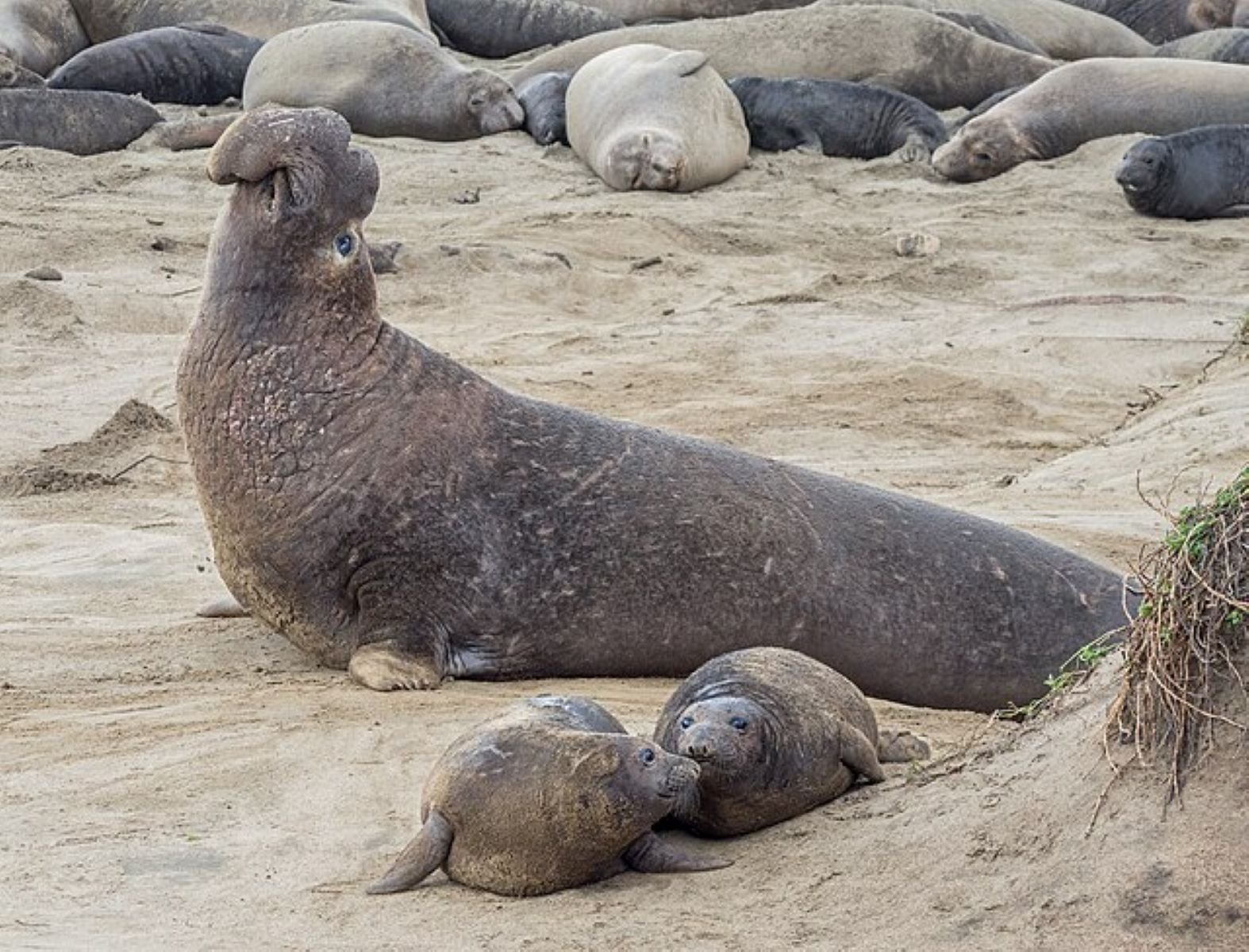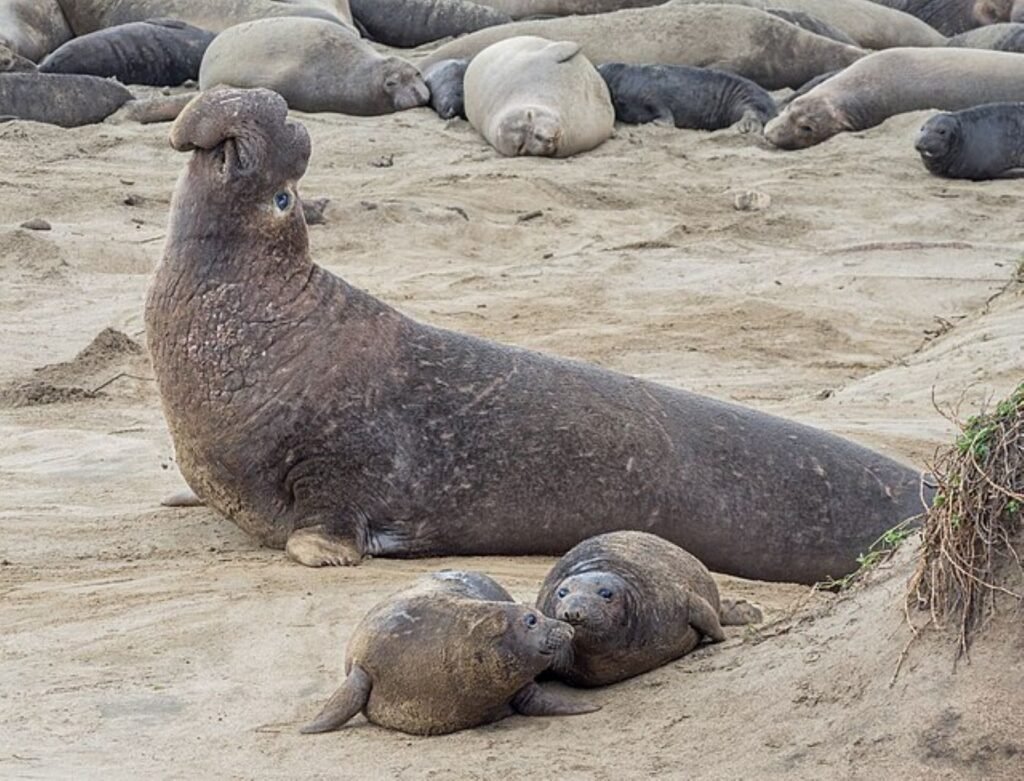Picture thousands of massive marine mammals scattered across pristine California beaches, their deep bellows echoing across the sand. These gentle giants weigh as much as small trucks yet they almost disappeared from our planet forever. Today, experiencing what scientists call one of the most remarkable conservation comebacks in modern history.
These incredible animals were once thought extinct after ruthless hunting in the late 1800s reduced their numbers to fewer than 100 individuals. Their recovery tells a powerful story of what happens when humans decide to protect rather than destroy. From near extinction to thriving populations that now exceed 300,000 individuals, elephant seals prove that conservation efforts can truly work miracles.
From the Brink of Extinction

In the late 19th century, they were nearly hunted to extinction for their blubber, which was valuable in oil production. By the end of the 1800s, only a small colony of fewer than 100 seals (some place the number closer to 25) was believed to exist. The massive marine mammals made perfect targets for commercial hunters who prized the oil that could be rendered from their thick layer of blubber.
By 1892, only 50 to 100 individuals were left. The only remaining colony was on the Guadalupe Island off the coast of Baja California. For decades, scientists believed these magnificent creatures had vanished forever. They were thought extinct after the last few that could be found were taken in 1892. Fortunately, around 20 had survived, and they made a remarkable comeback.
The Turning Point for Recovery

In 1922, the Mexican government deemed Isla de Guadalupe a biological reserve (stopped harassment and poaching) to protect the last remaining breeding colony. This protection is the reason why northern elephant seals still exist today. This single decision became the foundation for one of conservation’s greatest success stories.
In 1972, the U.S.A. enacted the Marine Mammal Protection Act, which protected all marine mammals in U.S. waters from hunting. This helped elephant seals recolonize their range in California. Subsequently, the U.S. protection was strengthened after passage of the Marine Mammal Protection Act of 1972, and numbers have now recovered to over 300,000.
Record-Breaking Population Growth

Mexico and the United States declared protections for this species, and northern elephant seals rebounded in a big way – there are an estimated 300,000 individuals today, and the population continues to grow every year. Some estimates suggest the current global population may reach as high as 250,000 individuals.
In California, the population is continuing to grow at around 6% per year, and new colonies are being established; they are now probably limited mostly by the availability of haul-out space. The growth of the site near San Simeon has proved even more spectacular; no animals were there prior to 1990. Currently, the San Simeon site hosts more breeding animals than Año Nuevo State Park during winter season.
Banner Year for Breeding Success

Northern elephant seals are in Point Reyes for their annual breeding season, which this year is off the charts. Unlike harbor seals, whose statewide population declines over several years have alarmed and puzzled scientists, northern elephant seals are booming largely due to this season’s clement weather. The 2024-2025 breeding season has researchers celebrating exceptional numbers.
Pup counts were higher than the five-year average this season. This is likely due to the lack of strong storms this winter. But the elephant seals have been spared from disaster this year. Storms struck during November, when the seals had not yet returned from the deep ocean to breed on land, leading to greater numbers.
Expanding Their Territory

As the elephant seals rebounded from near-extinction, they first re-established colonies on the islands off the shore of Baja California and California. When these rookeries became too crowded, they began colonizing mainland beaches. They began coming here in 1990. This expansion represents a natural response to population pressure and habitat availability.
In recent decades the breeding range has extended northwards. In 1976 the first pup was found on Point Reyes and a breeding colony established there in 1981. The seals continue pushing into new territories, with sightings now documented as far north as British Columbia and Alaska.
Prime California Habitat

The largest colonies of northern elephant seals are found off southern California in the Channel Islands. Most (~80%) of the U.S. population of elephant seals reside at the Channel Islands. The minimum population size for this stock in 2013 was conservatively estimated at around 85,000 seals.
Elephant seals like large sandy beaches that do not have a significant human presence. The rocky areas in the shallow waters provide the weaned pups some protection from breakers while they are learning to swim. The kelp forests, which are not far off shore, and the shallowness of the sea bed could help the seals avoid predation since shark attacks are more common in deeper water. California’s coastline provides nearly perfect conditions for these massive marine mammals.
Remarkable Life Cycle

Elephant seals are quite the punctual marine mammal. Pregnant female elephant seals undertake an approximately 240-day, 6,000-mile migration from their foraging grounds in the open ocean to their breeding grounds. Then, within around five days, they give birth to a pup. This incredible journey showcases their remarkable navigational abilities.
They have a black coat, which they molt, or shed, when they wean from their mothers at about 1 month old. During their first month of life, the pups nurse from their mothers and gain about 10 pounds a day. Adult females may mate several times before returning to the ocean, abruptly weaning their pups by desertion. By mid-March, most of the adult seals are gone, leaving the pups behind.
Ocean Giants with Extreme Features

Adult males are 14 to 16 feet (4 to 5 m) in length and 4,000 to 5,000 pounds (1,400 to 2,300 kg) in weight. The females are much smaller at about 9 to 12 feet (2.5 to 4 m) in length and weigh 900 to 1,800 pounds (400 to 800 kg). Pups are 3 to 4 feet (1 m) long at birth and weigh about 70 pounds (32 kg). These size differences create one of nature’s most dramatic examples of sexual dimorphism.
They have one of the longest migrations of any mammal; some have been recorded traveling over 13,000 miles roundtrip. At sea, elephant seals typically dive 20 minutes to a depth of 1,000 to 2,000 feet in search of food: rays, skates, rat fish, squid, and small sharks. The maximum recorded depth is 7,835 feet.
Hidden Challenges Beneath Success

Though the population recovery appears complete on the surface, recent research reveals concerning genetic consequences from their near-extinction bottleneck. Professor Rus Hoelzel, in the Department of Biosciences – Durham University, said, “In this study we looked at genetic variation across entire genomes from pre- and post-bottleneck northern elephant seals. We found that the fitness of post-bottleneck seals has been significantly impacted from increased inbreeding, the retention of genes that have lost their function, and the distortion of the frequency of genetic types across the population.”
So far, the species has recovered remarkably well, but these findings call into question how susceptible it might be to environmental stresses in the future. Research, led by Durham University, in collaboration with researchers in the U.S. and China, revealed that despite an apparent full recovery, the bottleneck has compromised key genes associated with reproductive success and the seals’ ability to forage efficiently. These hidden vulnerabilities could pose future challenges as environmental conditions continue changing.
A Conservation Success Story

The recovery of California’s elephant seals stands as one of the most inspiring conservation success stories of our time. It is important that we continue to monitor and protect elephant seal populations to ensure their long-term survival. The success of their recovery is a testament to the importance of conservation efforts and their positive impact on threatened species. Their journey from fewer than 100 survivors to thriving populations exceeding 300,000 demonstrates what becomes possible when humanity chooses protection over exploitation.
For fifty years, the Marine Mammal Protection Act (MMPA) and its federal protection for marine mammals has been a huge conservation success in the United States. It has been instrumental in the recovery of marine mammal populations like sea lions in California, the Hawaiian Monk seal, and manatees in Florida, amongst others. No marine mammal species has gone extinct in U.S. waters since the MMPA was enacted. The elephant seal recovery proves that strong legislation combined with dedicated conservation efforts can literally save species from extinction.
What do you think about this incredible conservation comeback? Tell us in the comments.

Jan loves Wildlife and Animals and is one of the founders of Animals Around The Globe. He holds an MSc in Finance & Economics and is a passionate PADI Open Water Diver. His favorite animals are Mountain Gorillas, Tigers, and Great White Sharks. He lived in South Africa, Germany, the USA, Ireland, Italy, China, and Australia. Before AATG, Jan worked for Google, Axel Springer, BMW and others.




